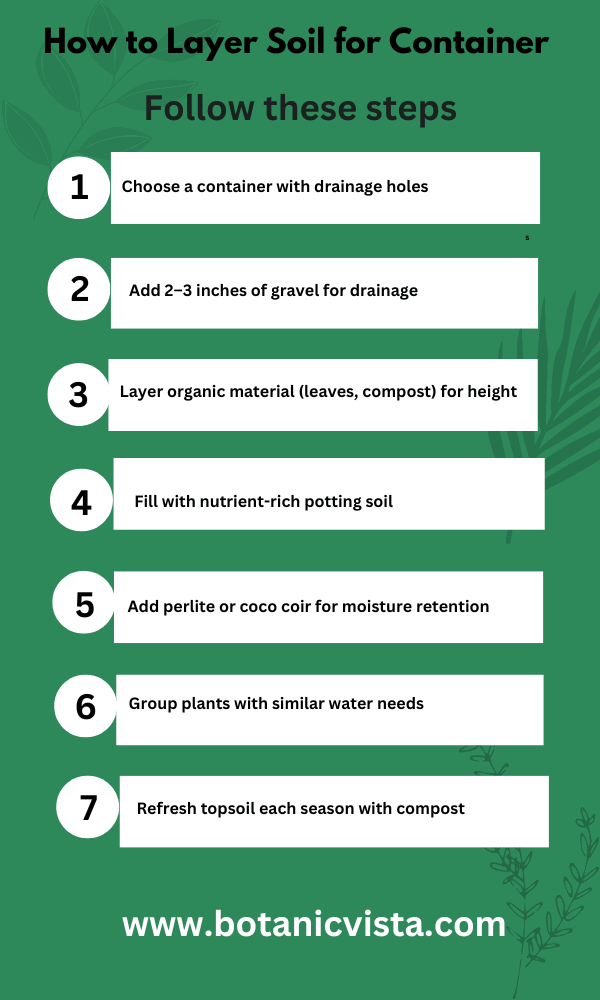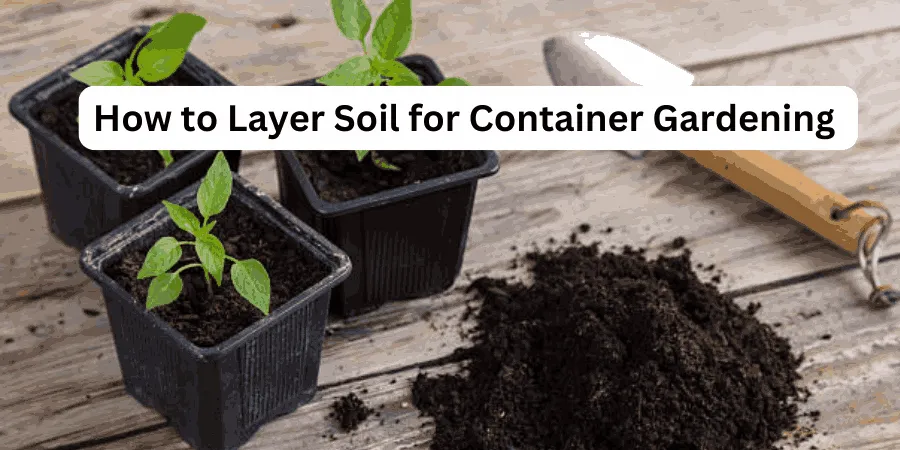Last Updated on October 14, 2024 by Jocelyn
When you start container gardening, you need to layer the soil. It helps with proper drainage, keeps the roots healthy, and makes sure the plants get enough nutrients. A well-layered container will help plants grow better and stay strong.
First, add a layer of small rocks or broken pieces at the bottom of the container. This helps water drain out, so the roots don’t stay too wet. Then, place a layer of organic material, like dried leaves or compost, to hold moisture and provide nutrients.
Finally, add a good quality potting mix on top. This light soil helps plants grow by giving them the right balance of nutrients and air. With these simple steps, you’ll set up a strong base for your plants to grow well in containers.
Keep reading to learn more about it!

Table of Contents
ToggleUnderstanding the Basics of Soil Layering
Layering soil in a container means arranging different types of materials in layers. This method helps plants get what they need from the soil. Each layer plays a role in giving the plant the right amount of nutrients and support for growth.
Soil layering helps control water retention by allowing excess water to drain while keeping enough moisture for the roots. By placing materials like rocks or pebbles at the bottom, you ensure proper drainage, while the soil on top holds just the right amount of water.
This is especially useful in indoor gardening setups where water management is crucial.
Step-by-Step Guide to Layering Soil in Containers
When you’re layering soil for container gardening, it’s important to know the right way to do it. This helps plants grow better in small spaces.
By organizing the layers well, you’ll ensure your plants get the nutrients and water they need.
1. Choosing the Right Container
When picking a container, choose one that suits your plant. Some pots are made of plastic, clay, or metal. Make sure your container has enough drainage holes at the bottom. In plastic pots, at least two or three holes are needed for proper water flow.
2. Bottom Layer: Creating Drainage
Start your container with a base layer. This layer could be gravel or small stones. It helps water flow away from the roots, stopping root rot. If you’re using a big pot, you can save some soil by adding things like broken pots, Styrofoam, or even plastic bottles at the bottom.
3. Middle Layer: Adding Organic Material for Height
The middle layer is where you add height to your container. You can use materials like mulch or organic matter, which can be an excellent way to enhance soil structure and moisture retention in your containers. Using mulch in a container garden can significantly improve your plant’s growth environment.
4. Top Layer: Potting Soil and Amendments
The top layer is the most important. Choose good-quality potting soil. You can make the soil better by adding things like perlite, vermiculite, or compost. These amendments help with better water flow and provide your plants with the nutrients they need.
How to Maintain and Refresh Container Soil
Container soil can get tired over time. To keep plants healthy, it’s important to refresh and maintain the soil regularly. This helps plants stay strong and keeps your garden growing well.
- Refreshing Container Soil for Longevity
After each planting season, refresh the soil to help your plants grow better. Remove some of the old soil and mix in fresh, nutrient-rich compost. This gives the soil the energy it needs for the next round of plants. You can also add slow-release fertilizers to boost soil quality.
- Soil Care Tips for Continuous Growth
To keep your soil healthy, add soil amendments like organic matter or worm castings regularly. Be careful not to overwater, as excessive moisture can lead to root rot.
If overwatering occurs, take steps to quickly fix overwatered plants and restore the right moisture balance. Testing soil moisture before watering can also help maintain the right balance.
Best Practices for Planting in Large Pots
Planting in large pots can be simple when you use the proper techniques. Big containers let you grow many plants but need careful layering. Adding the right layers makes plants grow well and keeps the pot stable.
1. Maximizing Space and Stability
To save soil, start with a light base like broken pots or rocks. This keeps the pot stable and helps drain excess water. You won’t need to use too much soil, which also helps the plant roots breathe better. As a tip, only use enough soil to cover the base layer.
2. Achieving Balance Between Layers
When layering, use materials that keep moisture while still allowing air. For example, add some compost in the middle layer. This helps keep water, so you won’t need to water often.
Make sure each layer is even, so the plant roots grow healthy and don’t get too wet. Too much soil can block airflow, so keep each layer balanced for the best results.
FAQ’s
Q: How Do You Prep Soil for Container Gardening?
A: Mix two parts of compost with one part of coconut coir for water retention. Add a small amount of perlite for drainage (about two handfuls per 45 liters) and include worm castings if extra nutrients are needed.
Finally, add a mycorrhizae starter to support root development.
Q: Can You Put Soil Directly Into Planter?
A: When starting a planter, add rocks at the bottom for better drainage and to create air pockets. You can put soil directly, but layering with rocks first and then a soil mix helps remove excess water and keeps the plant healthier.
Q: What Is a Good Soil Amendment for Potted Plants?
A: Start with rocks or gravel at the bottom for drainage to prevent root rot. Use a potting mix with high permeability to help water flow through.
For potted plants, add Perlite as a soil amendment to improve airflow and reduce low water retention, avoiding overwatering.
Q: Should You Change Soil in Pots Every Year?
A: Potted plants can use up nutrients over time, especially after 12 to 18 months. If they aren’t performing well, it’s a sign to refresh the soil. Changing soil every year helps keep your plants healthy.
Q: How to Revitalize Old Container Soil?
A: To revitalize old soil, remove old plant debris and fluff it up. Mix in fresh compost and well-rotted manure to improve fertility and add essential nutrients. Adjust the pH levels and ensure proper drainage to create the best environment for plant growth.
Conclusion
Container gardening is great for growing plants in small spaces. To help plants grow well, it’s important to layer the soil the right way. This keeps the soil healthy and gives roots the right amount of water and air.
Start with drainage at the bottom. Add small rocks or broken pottery pieces to let extra water flow out. Next, put a layer of coarse material, like gravel or wood chips, to improve airflow.
After that, use high-quality potting soil. Mix in organic matter like compost to give the plants nutrients.
Layering soil this way helps prevent water from building up, which keeps the roots from rotting. Always use the right type of soil for the plants you’re growing to ensure success. Try this method today and see the difference in your garden!

